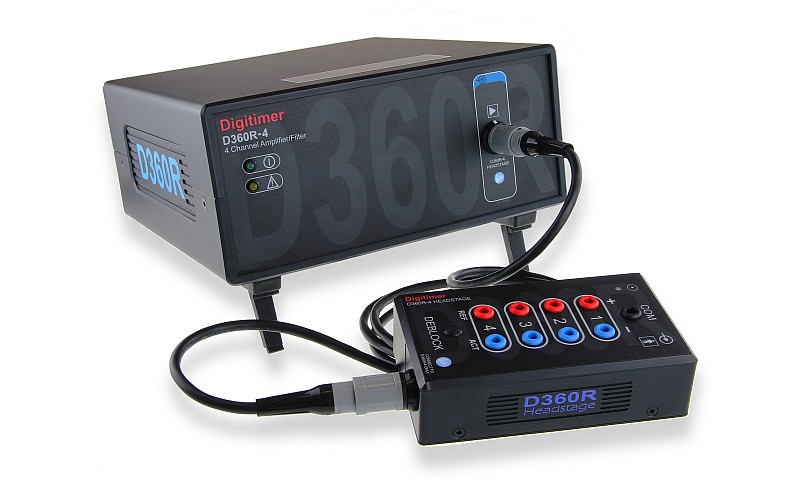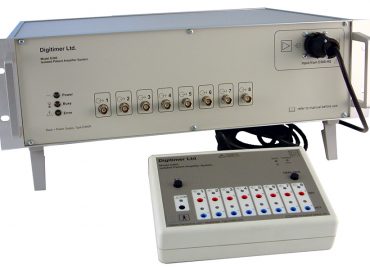Product Launch – D360R-4 Isolated Amplifier/Filter
New 4-Channel Human Research Amplifier Now Available
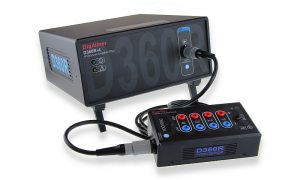
Digitimer is excited to announce the immediate availability of our latest product, the D360R-4 Four Channel Isolated Amplifier/Filter. Developed over the last two years, despite the Covid pandemic, this new general purpose human research amplifier was inspired by and uses the same circuitry as the medically certified 8-channel D360 Patient Amplifier.
While the 8 channel D360 remains extremely popular and is highly regarded within the clinical and research communities, many researchers do not need as many as 8 channels or require an amplifier with full medical device certification. Digitimer engineers have spent the last two years re-configuring the circuitry in the D360 and developing completely new firmware and software to produce a new amplifier with a reduced number of channels, which while not medically approved, is designed to meet the electrical requirements of IEC 60601-1 to ensure safe use in a human research environment.
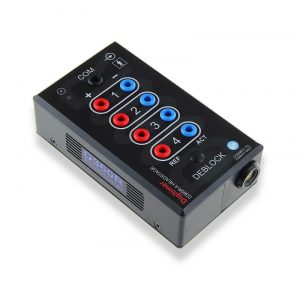
Field-testing of the D360R-4 was certainly made more challenging by the pandemic, but we are extremely grateful to those Digitimer customers that provided help during development of the D360R-4.
The D360R-4 comprises a main amplifier unit, a remote pre-amplifier headstage with 4 pairs of differential inputs (plus Common) and dedicated Windows-compatible Client Software. The software provides a virtual front panel for the adjustment of settings, including low-pass and high-pass filters as well as amplifier gain. The pre-amplifier headstage is attached to the main amplifier via a fully detachable 2m long cable, which is easily replaced if it becomes damaged during use.
As with the D360, the D360R-4 features a gain range of x100 to x3,000,000 and highly flexible filter settings, giving it tremendous versatility in applications as diverse as electromyography (EMG), evoked potential (EP) recordings and electroencephalography (EEG).
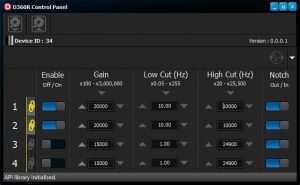
Analogue signal outputs mean that the D360R-4 is fully compatible with a vast array of commercially available data acquisition systems. As a result, the user can opt to employ their favoured data acquisition and analysis software. Amplified signal outputs are available on the rear panel via a 9-way “D” connector. The D360R-4 is supplied with a “D” to multi-BNC cable for connection to BNC-based data acquisition systems.
The D360R-4 supports system expansion as multiple D360R-4 amplifiers can be connected to a single computer (via several USB sockets or hub) to allow multiples of 4 channels to be controlled through a single software interface.
So how does the new D360R-4 differ from the D360?
One of the main drivers in the development of the D360R, was to produce a high performance research amplifier which matched the capabilities of the D360, but could be delivered at roughly half the cost. Consequently, this did mean that some of the more advanced features of the D360 did not get incorporated into the D360R-4, however, we have made several improvements in terms of software and hardware usability. A brief comparison between the D360 and D360R-4 have been covered in a previous blog article, but here is a more comprehensive list:-
- Unlike the D360, the D360R-4 is not designed, certified as or intended to be used as a medical device.
- The D360R-4 has four differential channels, whereas the D360 has eight.
- The D360 allows for internal linking of electrode inputs of the same polarity, so they share electrodes, the D360R does not and such linking would have to be undertaken using external wired connections.
- Electrode impedance checking is not available with the D360R-4. If impedance checking is required, we do offer our D175 handheld impedance meter.
- The D360R-4 software allows channel settings to be “linked”, but only allows for one linked group to be created, whereas the D360 allows for multiple independent groups.
- The D360 software permits channel re-naming, allowing different recording sites to be identified by a text entry. The D360R-4 numerically identifies channels.
- The D360 features a protocol manager that allows different user accounts to save and recall settings for different recording montages. With the D360R-4, this is simplified, with all saved protocols stored in the same location, irrespective of the Windows user account.
- When connecting to the host PC, the D360R-4 uses a standard USB cable and does not need a serial port or additional USB serial adaptor.
- Unlike the D360, the D360R-4 notch filter auto-selects to 50Hz or 60Hz depending on the mains frequency.
- The headstage cable for the D360R-4 is completely detachable, making it easy to replace in the event of damage.
- The D360R-4 Client Software and API are fully compatible with 64bit installations of data acquisition software, such as CED Spike2/Signal. When controlling the D360 from Spike2 or Signal, these programs needed to be installed as 32bit applications.
Register your interest in the D360R-4 by requesting a quote and receive a 10% launch discount!
If you would like to find out more about the new D360R-4, receive a quote or even arrange a no-obligation trial, please do get in touch with us.
